Samsung Galaxy S 4 Review - Part 1
by Brian Klug on April 24, 2013 12:01 AM ESTDisplay
We wrote about how we suspected that SGS4 would go to a 5-inch 1080p SAMOLED display just after CES. Turns out that was spot on, as the SGS4 includes a 5-inch 1080p Full HD SAMOLED panel, the latest in Samsung's AMOLED roadmap. Samsung's naming stays true, and there's no Plus tacked on at the end, so we get another non-RGB stripe subpixel geometry with SGS4. The last few Samsung AMOLED variants we've seen have had different subpixel grids, and the one on the SGS4 is possibly the most interesting to date. There's still a bias toward more green subpixels than blue or red, this isn't an RGB stripe at all, but instead of the previous RG,BG layout we see this offset pattern with green on one line, then blue and red on another line. Interestingly enough the blue subpixel appears to be a square, and red and green appear to be circles, with the difference in area possibly offsetting the luminous efficiency of each material. Whatever the reason (Samsung has never been official or forthcoming any of these subpixel patterns each time they've changed them) it's present on the SGS4.
At this size however I have to admit that I find the pursuit of the subpixel geometry more of an educational one than something which affects users. While I could occasionally see it on the SGS3, I definitely do not see it on SGS4. The subpixels are now small enough that whatever the pattern, it all looks like a homogenous light-emitting surface, which was the goal after all. I could bring up the visual acuity discussion again but just trust me that it's small enough to not be visible even with actually perfect (not legally perfect, which is different) vision.
So resolution is great and up to par with all the other LCD-bearing flagships this year, lack of RGB stripe notwithstanding. There's that remaining question about brightness, contrast, outdoor visibility, and of course calibration and the saturation issue that has persisted with AMOLED from generation to generation.
On the brightness front, the SGS4 includes dynamic contrast functions that cannot be disabled and change as a function of what is being displayed. There's an "auto adjust screen tone" checkbox under display but don't let that fool you, that doesn't disable dynamic contrast, just white point. Under screen mode are the mDNIe toggles we've seen on countless other previous Samsung Android phones with AMOLED panels, only here we notice something interesting. There have always been four toggles as long as this option has existed, only what's different is now, one of them is named "Professional photo." Reviews of other regional variants of the SGS4 have included the same button but marked "Adobe RGB." Oddly enough it seems that the North American versions at least have this renamed for some reason, but undoubtedly the function is the same. Many speculated that this is now a toggle for some full CMS (Color Management System) which "fixes" the inherent color space issues with AMOLED and oversaturation that occurs when looking at sRGB content on such devices. Unfortunately, I can confirm that my initial suspicions that this is just a continuation of the mDNIe (lite) settings from previous generation is in fact correct. I reverse engineered what I could of these settings from both kernel messages while changing the toggles, and looking at the kernel sources. Turns out that 'Professional photo' mode is actually the 'Natural' mode renamed from previous versions.
So the question was whether the color space or white point actually does change with this mode enabled. I ran the SGS4 through our display tests in each of the modes and think the full color space plot tells the story. The sanest of them all really ends up being the strangely-named 'Movie' mode. Professional photo gives the big gamut with a white point closer to 'Movie,' which is to say around 7000K, but it doesn't fundamentally change the still-present oversaturation or color management issue that exists in Android with these wide gamut displays. Most users admittedly don't care however and just see "bright" colors. Theres' an Auto mode as well which the device ships with that basically has a matrix of mDNIe settings for targeted applications (for example the Gallery, Browser, Video playback) and so forth get settings, which you can see in the kernel.
| CalMAN Display Comparison | ||||||||||||
| Metric | iPhone 5 | iPhone 4S | HTC One X | SGS3 | Samsung Galaxy Note 2 | Google Nexus 4 | HTC Droid DNA | HTC One | SGS4 | |||
| Grayscale 200nits Avg dE2000 | 3.564 | 6.162 | 6.609 | 4.578 | 5.867 | 7.686 | 6.738 | 5.391 | 7.511 | |||
| CCT Avg (K) | 6925 | 7171 | 5944 | 6809 | 7109 | 8506 | 8108 | 8118 | 7020 | |||
| Saturation Sweep Avg dE2000 | 3.591 | 8.787 | 5.066 | 5.460 | 7.986 | 8.517 | 5.856 | 3.365 | 7.823 | |||
| GMB ColorChecker Avg dE2000 | 4.747 | 6.328 | 6.963 | 7.322 | 8.185 | 7.531 | 6.687 | 4.656 | 7.440 | |||
In the "Movie" mode things are better controlled than the Note 2 on the GMB color checker card test, which is the most important one for me. White point is also no longer the crazy 8000K that we saw before, 7000K is commendable for Samsung at this point. Keep in mind that maximum brightness changes in each mode as well as we effectively clamp things, I measured a maximum of 319 nits in Dynamic mode, 311 nits in Movie mode, and 255 nits in Standard, for example.
Running the display at maximum brightness for too long will also get you into an overheating or thermal protection mode as well, which we've seen on countless other AMOLED variants. Most of the time I suspect users will run on Auto brightness however which keeps brightness down to a much lower level to save battery and prevent that from becoming a problem.
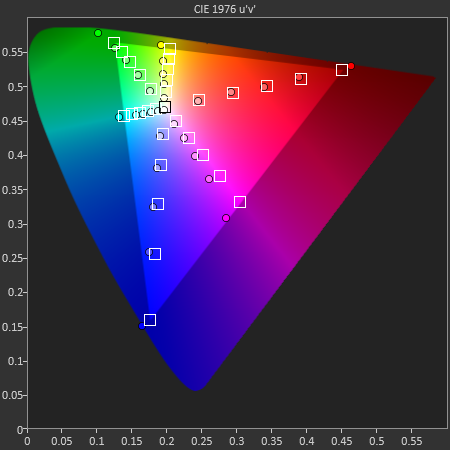
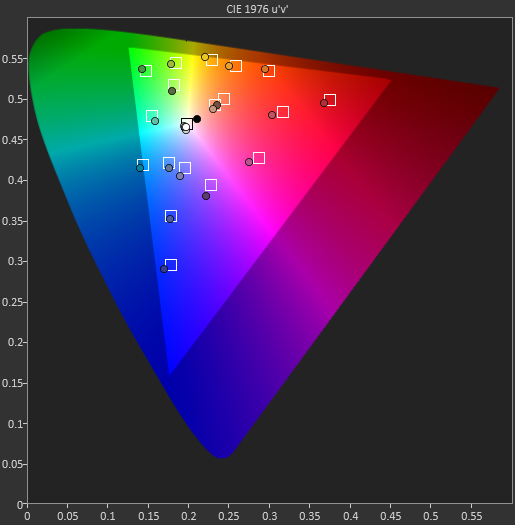
Because "Movie" was the closest to sRGB of all the modes, I selected it for the actual results that I'll present in the table. Admittedly this mode does tighten things up a bit, but it still isn't perfect and I'd still like to see Samsung do something to reign this in at some point.


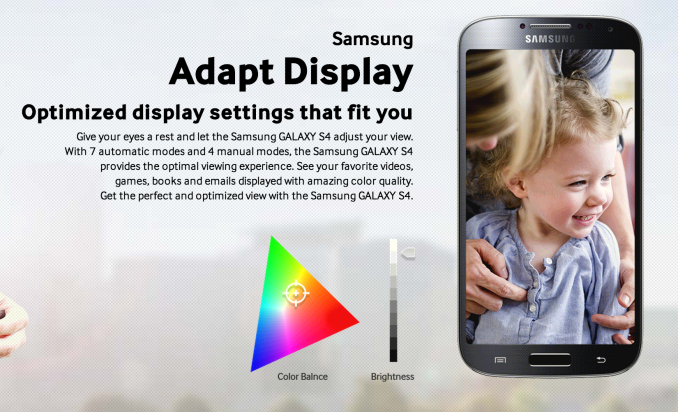




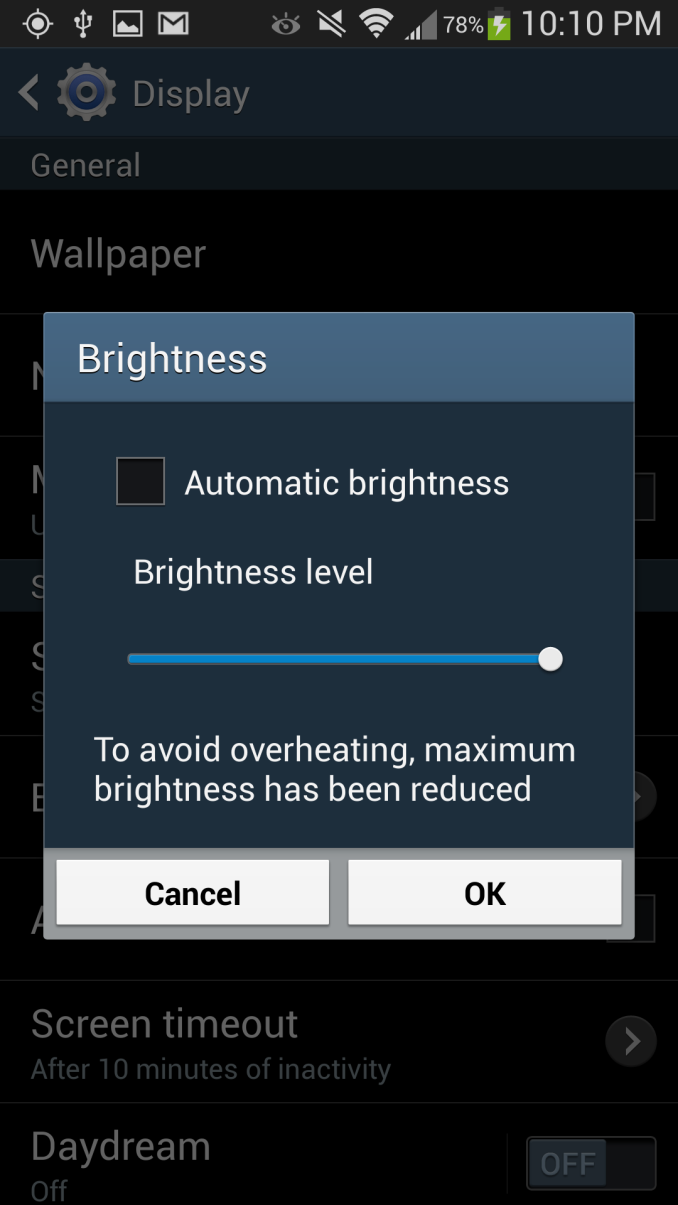
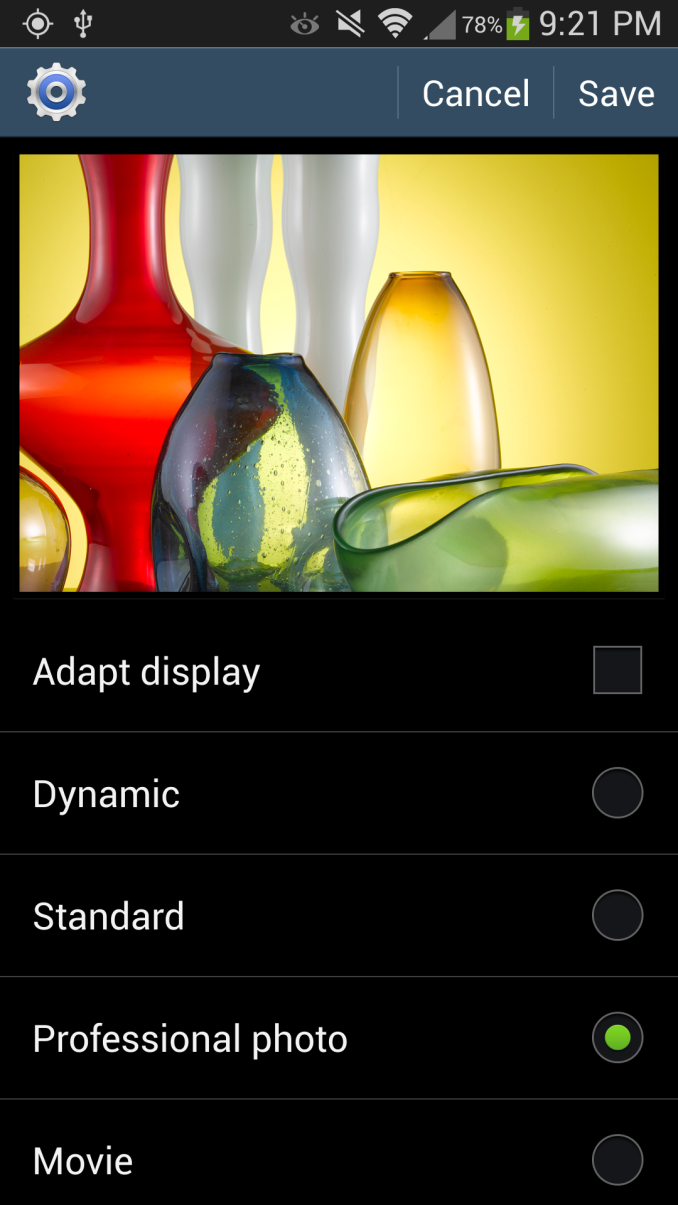
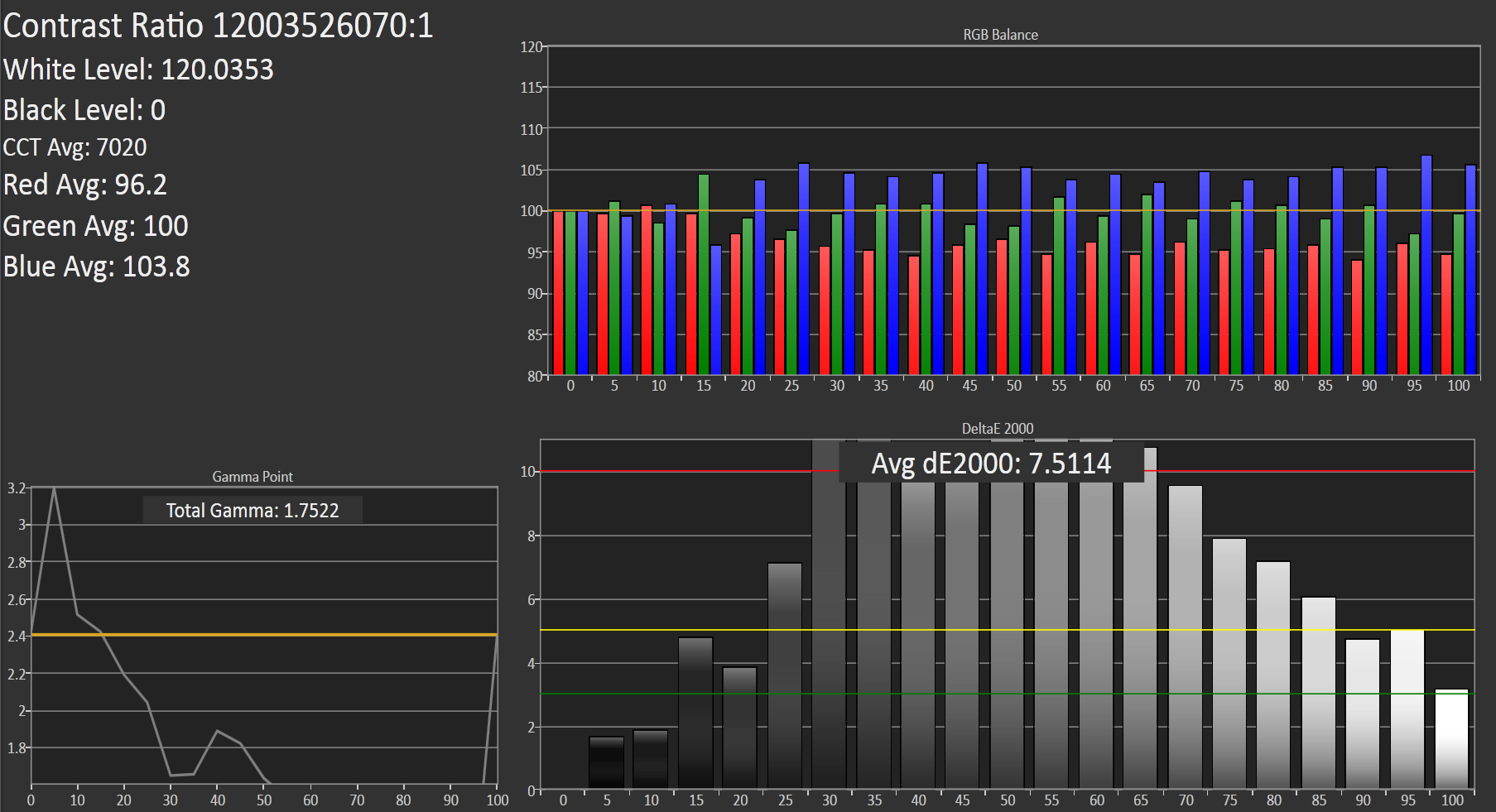








335 Comments
View All Comments
blue_urban_sky - Friday, April 26, 2013 - link
Not saying that. the ability of plastic to flex enables the little catches around the case to lock/unlock easily. to do that with alu you need a mechanical release which increases complexity. As a material plastic has advantages over glass/Alu and personally I don't mind it, not saying that I don't appreciate other materials just that as a functional cover it does its job well.CoryS - Friday, April 26, 2013 - link
The Droid X had a metal back plate, without a mechanical release. It also always came off in your pocket..zero2dash - Wednesday, April 24, 2013 - link
I'd rather have a plastic shell with a removable battery and a microSD slot than a metal frame with neither.But hey, whatever's most important to you...
xype - Thursday, April 25, 2013 - link
How often have you removed/changed your smartphone battery in the past? Just curious how often people who find the feature important use it (since I don’t know anyone who does so in real life).CoryS - Friday, April 26, 2013 - link
I did it daily with my Gnex. But, never have had the need with any other phone. The peace of mind is nice though. I think I have found I no longer need to swap batteries as much because I have changed my usage model to the battery life of the device...meaning I don't use my phone as much so it doesn't die.RiotSloth - Saturday, April 27, 2013 - link
I have an S3 with 2 batteries - I don't think I have ever swapped the battery out because I have a charger in my car and at work. Love dragging those batteries around and keeping them charged though.... and of course people buy phones because of how they look or what they are - saying that isn't so is just denial. Just because tech geeks don't doesn't mean others don't. How many people do you know who have phones they barely know how to use, but bought because they had heard its 'the one to get'?Androidtech - Sunday, April 28, 2013 - link
For all of you talking about removable batteries. I have both the Galaxy S3 and the HTC EVO 4g LTE. Out of these two phones the Galaxy S3 is my primary phone while the HTC Evo tags along and gets used randomly when I think about it. This is because I use my phone constantly and I stream podcast all day long at work to a bluetooth speaker. When I run one battery down I just pop in the other one and start charging the backup with the handy dandy Sammy battery/charger combo pack. Since my job is one that I am always on the move this is a great feature for me. I build oilfield pump packages and rebuild Industrial gearboxes like those used in ships and sugar mills.The ones in the ship turn the giant propellers and the ones in the sugar mills turn giant grinders. I also do welding and fabrication. So in a job like this I am always getting tools and moving from one part of a project to the next part or the next project. I am almost always standing up. This is much different than an office job where I could just plug my phone in at my desk. Even then why would I want a wire attached to my phone. Personally I would prefer a metal phone with a mechanically removable back maybe like the HTC Amaze 4g. Also as far as the case discussion goes There is no way I would use either of my phones with out a case and screen protector especially in my work environment. I like to keep my devices in top shape so when I am ready to get a new one next year I can sell it for top dollar or hand it over to my wife so I can use her upgrade again. That way I can say hey baby here is a nice phone and it still looks brand new ! She does not care about the latest and greatest or the fact that she is a year or two behind current technology and I always have the newest thing out since I am rotating 4 upgrades if you include my stepsons phone. You see there really is no reason to argue or try to decide which phone is better just get one HTC phone and one Samsung phone and enjoy the different qualities that each brings forth. Just be the one that pays for the famliy mobile Bill and you too can use everyones upgrade and stay on top of the cutting edge handset race. Works for me !Dug - Monday, April 29, 2013 - link
I don't know anyone or have seen anyone that changes their battery. In a company of 200 tech geeks I would think that this would be the majority and probably why HTC went away from it.TedKord - Thursday, May 2, 2013 - link
I'm a very heavy user. Hours of streaming Netflix, surfing endlessly. I can carry a second battery, and just swap out when the first runs down. I don't have to worry about carrying a plug,So to answer your question, I have at times swapped out my battery every day for months on end. Now, I'm rocking a 4500mah extended battery, and I always make it through the day.
I have a buddy at work who had an iPhone 4s, and it's battery had nearly died. He was getting a couple of hours max, but was out of warranty. He'd have killed for a swappable battery. Instead, after using my SGS3 and being impressed, he went out and got a Note 2, and left Apple all together. He hasn't regretted it a bit.
RiotSloth - Saturday, May 11, 2013 - link
Although you can change the battery in an iPhone fairly easily... or he could buy a mophie. I think everything has been said now about batteries - to some people it matters, to others it doesn't.